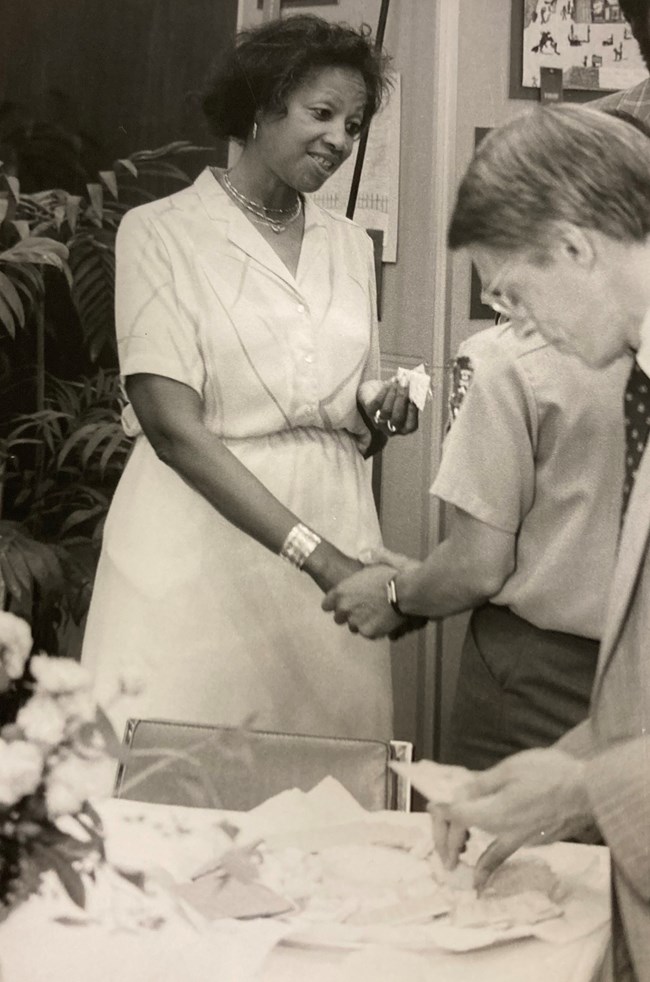Last updated: March 1, 2022
Article
Dorothea L. Powell
Dorothea Louise Potter was born on October 13, 1925, in Boston, Massachusetts, the eldest of 10 children. Right after high school she married a man with the surname Washington. They had a daughter and a son. When the children were older, she worked in a laundry company, followed by 17 years with BFGoodrich Company making fuel cells for jet bombers, among other things. It’s not clear what became of that marriage, but she married Leroy Powell in 1968.
That same year, when she was in her 40s, Powell began college at Northeastern University in Boston. She graduated cum laude with a BA in sociology in 1974. She worked as a social worker for two and a half years before being hired by the US Air Force in 1973 at Hansom Air Base.
Contact with a former coworker who was working for the National Park Service (NPS) led Powell to a temporary clerk position in 1974. She was the first Black woman to work in the NPS North Atlantic Regional Office. She worked her way into clerk-typist and personnel clerk positions, becoming a personnel staffing specialist.

By the early 1980s Powell was looking for new challenges. Her supervisors and colleagues in the regional office encouraged her to apply to become the manager of the new Boston African American National Historic Site, which was established to commemorate the community of free Afro-Americans which mounted resistance to the forces of slavery and segregation in the years leading up to and including the Civil War. She got the job and became the park’s first site manager in August 1981.
Initially the staff consisted of Powell and interpretive ranger Ted Fowler. Powell found it difficult at first, as she had never worked as a park ranger or in interpretation. As site manager she connected with the community, joined local organizations, and performed administrative duties. She also worked with Fowler to coordinate a Black history events calendar and several exhibits, including one in 1985 that focused on women.
Powell later recalled, “I knew it would be a real challenge, but I also thought it would be fun and something I could relate to—it being a Black historical site and me being born and raised in Boston.” She stated, “We got out on the Black Heritage Trail and were seen in uniform; before that people didn’t know there were Black park rangers in Boston.”
Powell also had a family connection to the site. Her grandfather enlisted in the Civil War at the African Meeting House, the oldest surviving Black church structure in the United States. She explained, “That link made me push as much as I did for things.” After meeting with a Congressional aide, one million dollars was allocated for restoration of buildings at the park. The restoration of the meeting house—while unfinished at the time—was revealed to the public on October 13, 1987, the day Powell retired.
Asked about the role of women in the NPS in a 1986 interview, Powell stated, “I think they need women in the Park Service to give it an extra little something…Women have a way of knowing that certain little things have to be done to make the big picture…It’s been a good ol’ boy type of thing and I think—especially in urban parks—I really think they need women.”
Powell’s NPS career lasted 13 years. In retirement she moved with her husband to Albuquerque, New Mexico. Dorothea L. Powell died on August 8, 2006, in Albuquerque and is buried in Pajarito, New Mexico.
Sources:
National Park Service. (1988, February). “Retirement.” Courier: The National Park Service Newsletter, 33 (20), pp 40.
National Park Service. (1981, October). “New Division and Chiefs for Recreation Resources.” Courier: The National Park Service Newsletter, 4 (10), pp 16.
National Park Service. (1981, December). “People on the Move.” Courier: The National Park Service Newsletter, 4 (12), pp 18.
Powell, Dorthea L. interview. (1986, March 6). Polly Kaufman Collection. NPS History Collection, Harpers Ferry Center.
"Powell Obituary." (2006, Aug 17). Albuquerque Journal, pp 20.
Explore More!
To learn more about women and the NPS Uniform, visit Dressing the Part: A Portfolio of Women’s History in the NPS.
This research was made possible in part by a grant from the National Park Foundation.
